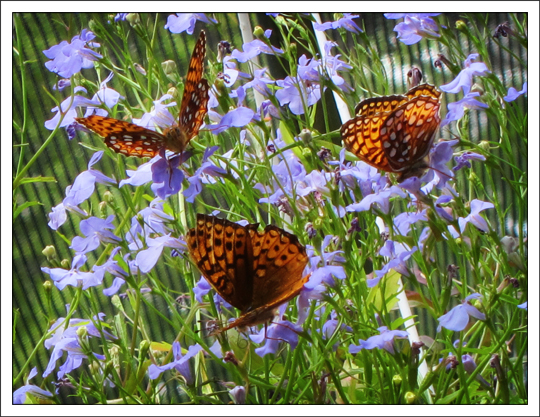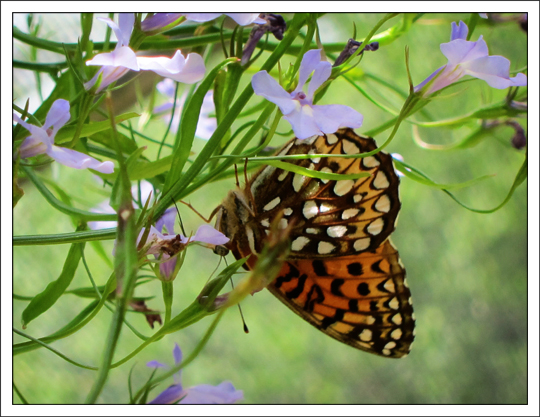Butterflies of the Adirondack Mountains:
Atlantis Fritillary (Speyeria atlantis)
 Butterflies of the Adirondacks: Atlantis Fritillary in the Paul Smiths VIC Butterfly House (30 July 2012)
Butterflies of the Adirondacks: Atlantis Fritillary in the Paul Smiths VIC Butterfly House (30 July 2012)
| This page is no longer being updated. For an updated version of this material, see: Atlantis Fritillary (Speyeria atlantis). |
The Atlantis Fritillary (Speyeria atlantis) is a medium-sized orange butterfly which may be seen in the Adirondack Mountains of upstate New York in mid- and late summer. The species is named after Atlantis, a legendary island first mentioned by Plato. Some sources refer to Speyeria atlantis as Mountain Silver-spot.[1] It is said to be the most boreal of the three large, orange-dappled fritillaries. [2] [3]
The appearance of the Atlantis Butterfly is said to be quite variable. [4] [5] The Atlantis Fritillaries we see here in our part of the Adirondacks may not necessarily be identical to those portrayed in butterfly books. [6] This variability may be due to differences in moisture and temperature. [7]
Most desciprtions of the Atlantis indicate that the upper side is orange-brown, lighter yellow or yellowish orange in the female, [8] with a complex black pattern of spots, bars, chevrons, and broadly darkened veins. [9] [10] The upper side is suffused with black at the base and usually has a solid black margin on the fore wings and often on the hind wings as well. [11] [12] [13] [14] The under side of the hind wing is purplish brown and has many silvery-white spots. [15] [16] [17] The wing span of the Atlantis Fritillary is 2.4 inches.[18]
The Atlantis Fritillary is easily confused with both the Great Spangled Fritillary and the Aphrodite Fritillary; and experts do not always agree on how to distinguish the two. Most sources agree that the Atlantis Fritillary is somewhat smaller than the Great Spangled and Aphrodite. [19] [20] The Aphrodite is generally lighter orange above with orange rather than solid black borders on the wings, [21] [22] [23] [24] and bright reddish orange rather than dark purplish brown on the hind wings beneath. [25] [26] In the Atlantis Fritillary, the black spot at the base of the fore wing from above is usually faint or absent. [27]
 Butterflies of the Adirondacks: Atlantis Fritillary in the Paul Smiths VIC Butterfly House (23 June 2012)
Butterflies of the Adirondacks: Atlantis Fritillary in the Paul Smiths VIC Butterfly House (23 June 2012)
Male Atlantis Fritillaries patrol during the day in forested areas or along streams. [28] [29] Females lay their eggs singly on leaf litter. [30] The eggs are honey-yellow and are laid near violets. [31] After hatching, the caterpillars overwinter. [32] [33] Mature caterpillars are variable in appearance; [34] some are velvety black with grey or brown stripes and orange spines. [35] Caterpillars feed on violets. [36] [37] [38] [39] Adult butterflies consume flower nectar, including that from mountain laurel, ox-eye daisy, spirea, and common milkweed. [40] [41]
The habitat of the Atlantis Fritillary includes forest openings, upland pastures, bogs, areas near woodland streams, and meadows. [42] [43] [44] [45] It is most common in boreal habitats. [46] [47] The Atlantis Fritillary is found in Canada from the Maritime Provinces and the northeastern portions of the US south to West Virginia, west through the Great Lakes region. [48] [49]
 Butterflies of the Adirondacks: Atlantis Fritillary in the Paul Smiths VIC Butterfly House (16 June 2012)
Butterflies of the Adirondacks: Atlantis Fritillary in the Paul Smiths VIC Butterfly House (16 June 2012)
Experts disagree on the flight period for this butterfly. Some sources indicate that the normal flight period for the Atlantis Fritillary is from late June to August or early September. [50] [51] [52] Others list the flight period from mid-June through mid-September, [53] [54] while still others suggest a flight period mostly in July and August. [55] The flight period apparently varies with latitude and elevation. [56]
The normal flight period for Atlantis Fritillaries in northern New York State and the Adirondack Mountains has not been established. However, over the last decade, observers have reported sightings of the Atlantis Fritillary in the Adirondack Park from late June to early September. [57] In 2012, Atlantis Fritillaries were seen in the Paul Smiths VIC Native Species Butterfly House and in the adjacent Butterfly Garden from mid-June through August. [58]
References
- Susan Grimm Hanley. Interpretive Naturalist, Paul Smith's College Native Species Butterfly House. Species Logbooks.
- Butterflies and Moths of North American. Species Profiles. Confirmed sightings: 6/16/12; 7/12/12; 7/30/12
- Government of Canada. Canadian Biodiversity Information Facility. SpeciesBank.
- Massachusetts Butterfly Club. Massachusetts Butterfly Species List.
- ENature. Field Guides.
- Iowa State University. Department of Entomology. BugGuide.
- University of Alberta. Department of Biological Sciences. E.H. Strickland Entomological Museum. Speyeria atlantis.
- Yahoo Groups. NYSButterflies. Butterflies & Moths of New York.
- Ross A. Layberry, Peter W. Hall, and J. Donald Lafontaine. The Butterflies of Canada (University of Toronto Press, 1998), p. 172, Plates 13, 21, and 27.
- National Audubon Society. Field Guide to Butterflies (New York: Alfred A. Knopf, 1981), pp. 554-555.
- Jim P. Brock and Kenn Kaufman. Kaufman Field Guide to Butterflies of North America (Houghton Mifflin, 2003), pp. 166-167.
- Paul A. Opler. A Field Guide to Eastern Butterflies (The Peterson Field Guide Series, Houghton Mifflin Company, 1992,1998), pp. 82-83, 240-241.
- James A. Scott. The Butterflies of North America. A Natural History and Field Guide (Stanford University Press, 1986), pp. 330-332.
- Jeffrey Glassberg. Butterflies through Binoculars. The East. A Field Guide to the Butterflies of Eastern North America (Oxford University Press, 1999), p. 106, Plate 28.
- Paul A. Opler and George O. Krizek. Butterflies East of the Great Plains: An Illustrated Natural History (The Johns Hopkins University Press, 1984), pp. 135-136, Plate 23.
- Rick Cech and Guy Tudor. Butterflies of the East Coast. An Observer's Guide (Princeton University Press, 2005), p.165.
- Thomas J. Allen, Jim P. Brock, and Jeffrey Glassberg. Caterpillars in the Field and Garden. A Field Guide to the Butterfly Caterpillars of North America (Oxford University Press, 2005), pp. 82-83.
